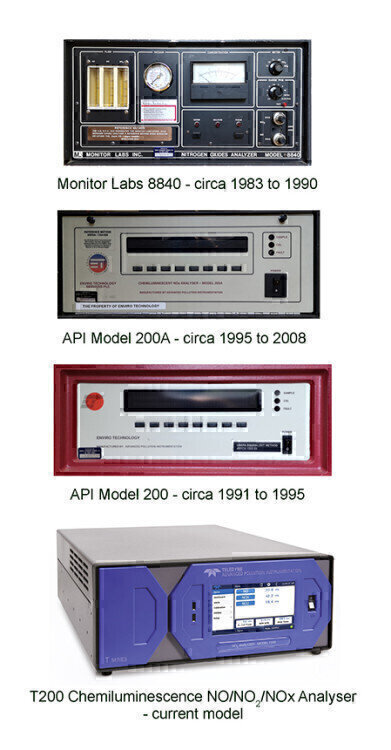Air Monitoring
The story of real-time NOx and NO2 monitors: past, present and future
Nov 30 2020
Since 1983, Enviro Technology (ET) has witnessed the evolution of NOx analysers, from large, heavy, analogue beginnings through to some of the svelte, lightweight technically superior digital instruments available today.
The requirement for measuring NOx began with the exponential rise of the motor car in the 1970s and the impact of poor air quality on human health.
In the 1970’s Chemiluminescence became the primary method for monitoring NOx and has long since been designated a ‘reference method’, even to this day. This relatively inexpensive, reliable, and well-studied technique is used the world over.
ET’s best-selling NOx analyser, the Teledyne-API T200 is a direct descendant of one of the earliest chemiluminescence analysers, the ML8840. Despite many upgrades that have improved functionality, reliability, and ease of use, the basic components of a modern chemiluminescence NOx analyser are fundamentally the same as in the 1970s.
Chemiluminescence NOx analysers don’t actually measure NO2 at all, but instead calculate it from the two-stage ‘NOx - NO = NO2’ formula, and subject to potential overestimation.
Along this journey, ET’s long-standing analyser suppliers like Teledyne-API and Opsis have developed a succession of new technologies and have been joined by newer entrants like LGR and AirYX, each with unique and novel principles of measurement.
As well as chemiluminescence, ET offers a choice of innovative NOx and NO2 instruments depending on application and budget. The ET range, available throughout the UK includes a photolytic “blue light converter” (BLC) replaces the heated molybdenum converter, in a NOx analyser with an array of high-efficiency LEDs, offering improved selectivity and improved NO2 measurement.
Another technique available from ET is Cavity Attenuated Phase Shift Spectroscopy (CAPS), another recently evolved method providing fast response times due to direct measurement of NO2 rather than a catalytic conversion process; a completely ‘non-chemiluminescence’ method. Another option is cavity ring-down spectroscopy which measures the absorption of ultraviolet light indirectly resulting in high precision performance, whereas Iterative Cavity-enhanced DOAS (ICAD) makes it possible to measure NO2 with direct optical absorption, by using DOAS and the ICAD algorithm to separate the NO2 absorption signal from overlapping signals. ET also offer a UV DOAS solution using an open measurement path, which has been available since the late 1980’s. It provides an averaged measurement over the entire path between an emitter and receiver and has the added benefit of measuring other gases simultaneously like SO2, O3 and BTEX.
With almost four decades of experience of working with NOx and NO2 analysers, Enviro Technology can expertly help you make the right measurement decisions.
Digital Edition
IET 34.2 March 2024
April 2024
Gas Detection - Biogas batch fermentation system for laboratory use with automatic gas analysis in real time Water/Wastewater - Upcycling sensors for sustainable nature management - Prist...
View all digital editions
Events
Apr 30 2024 Melbourne, Australia
Apr 30 2024 Birmingham, UK
May 03 2024 Seoul, South Korea
May 05 2024 Seville, Spain
May 06 2024 Minneapolis, MN, USA


















